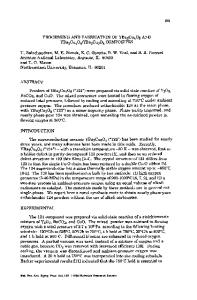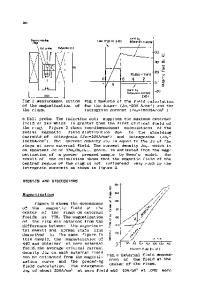Processing tetramethylammonium-carbonate-coprecipitated slurries to obtain small-particle-size YBa 2 Cu 3 O 7
- PDF / 940,757 Bytes
- 7 Pages / 594 x 792 pts Page_size
- 82 Downloads / 238 Views
I. INTRODUCTION
The control of particle size in high-Jc superconductors is of great importance, since for nonporous materials it is the particle size that determines the surface free energy. Small particle size translates into high surface free energy, which is the driving force for sintering into solid bodies. In addition, the use of small (submicron) superconductor particles greatly facilitates both screen printing and photolithographic processes, both of which are promising methods for the fabrication of superconducting devices.1'2 Particle-size reduction may be achieved by grinding or milling, but this approach has several drawbacks. Firstly, most milling techniques involve solid media, which themselves are subject to attrition, leading to contamination of the superconductor powder. Secondly, it is difficult to achieve submicron particle sizes by mechanical milling processes. Thirdly, mechanical milling can lead to a degradation of the superconducting properties of the powder. The present study concerns the processing of a coprecipitated carbonate slurry to produce small-particlesize YBa 2 Cu 3 O 7 (Y-123). The impact of processing steps on the ultimate particle size has been investigated, and a route to submicron material developed. II. EXPERIMENTAL
Tetramethylammonium (TMA) carbonate was used as a precipitating agent.3"6 It was prepared by bubbling carbon dioxide through TMA hydroxide (25 wt. %, Southwestern Analytical Chemicals) until the pH was 10.0. This reagent is an ionic carbonate with the added advantage of decomposing into gaseous products at a)
Grace-Atholton High School Mentor Program Participant. Current Address: University of Maryland, College Park, Maryland 20742.
220 http://journals.cambridge.org
J. Mater. Res., Vol. 6, No. 2, Feb 1991 Downloaded: 14 Mar 2015
temperatures below 500 °C. The precipitation was carried out by simultaneously dripping equal volumes of a 0.05 M stoichiometric solution of the metal nitrates (99.9%, Aldrich Chemical Co.) and 0.6 M TMA carbonate solution (pH = 10) into another equal volume of distilled water over a period of 30 min. The precipitation vessel was stirred continuously during this time, and the pH maintained at 9.00 by the addition of 25 wt. % TMA hydroxide. After precipitation, the slurry was stirred for a further 30 min before subsequent processing stages. Figure 1 shows the various combinations of processing steps that were used to investigate sensitivity of ultimate particle size to prior treatment. Since the particle size of the precipitate is —0.1-0.5 jxm, an ideal processing sequence would preserve this particle size without further agglomeration. As an alternative to conventional filtration and drying, spray-drying was used in the preparation of several samples (Yamato GB-21, inlet temperature 150 °C, 7.5 cfm aspiration rate, flowing N2). Sample 1 was spray-dried directly from the precipitation vessel, but this approach was abandoned due to the difficulty in obtaining a dry powder in the presence of the highly deliquescent TMA salts. A more promi
Data Loading...











